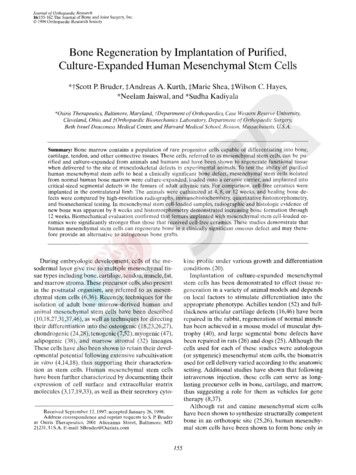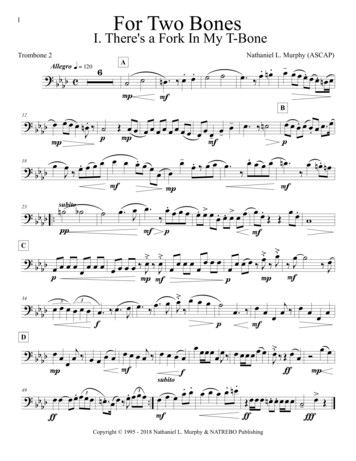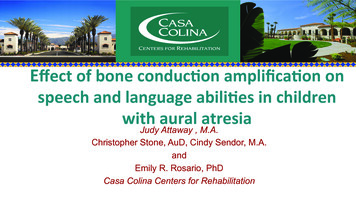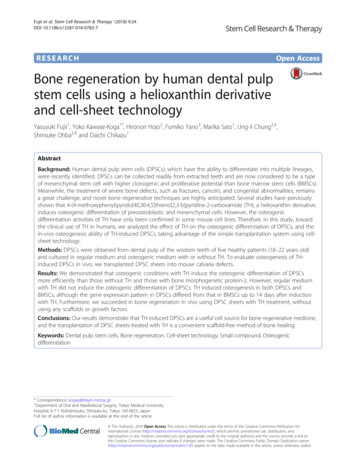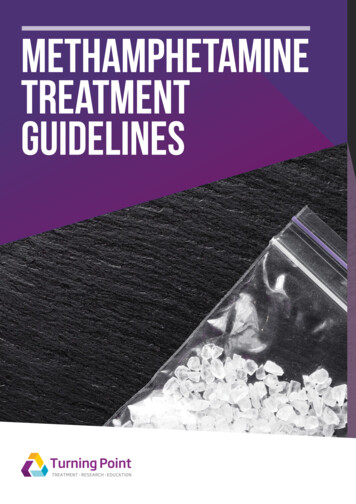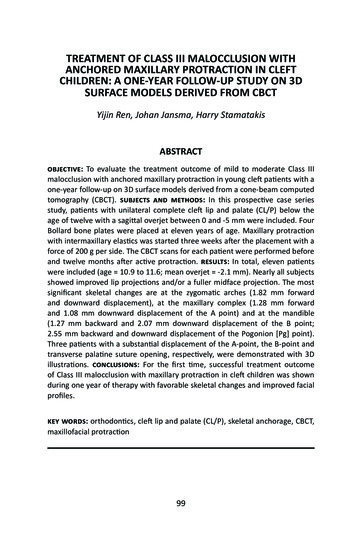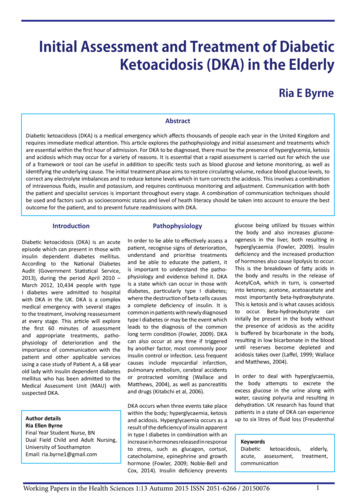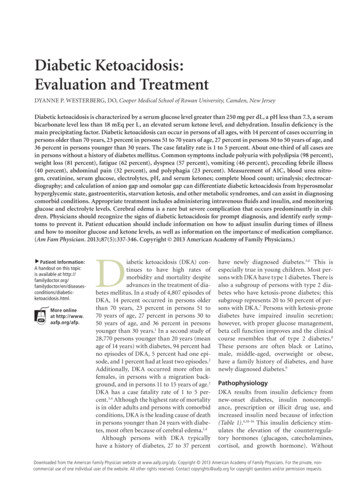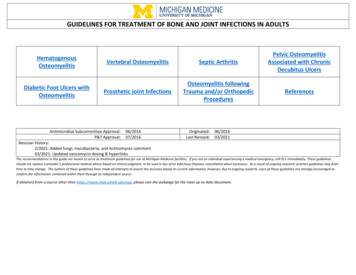
Transcription
GUIDELINES FOR TREATMENT OF BONE AND JOINT INFECTIONS IN ADULTSHematogenousOsteomyelitisDiabetic Foot Ulcers withOsteomyelitisVertebral OsteomyelitisSeptic ArthritisPelvic OsteomyelitisAssociated with ChronicDecubitus UlcersProsthetic Joint InfectionsOsteomyelitis followingTrauma and/or OrthopedicProceduresReferencesAntimicrobial Subcommittee Approval:P&T Approval:06/201607/2016Originated:Last Revised:06/201603/2021Revision History:2/2021: Added fungi, mycobacteria, and Actinomyces comment03/2021: Updated vancomycin dosing & hyperlinksThe recommendations in this guide are meant to serve as treatment guidelines for use at Michigan Medicine facilities. If you are an individual experiencing a medical emergency, call 911 immediately. These guidelinesshould not replace a provider’s professional medical advice based on clinical judgment, or be used in lieu of an Infectious Diseases consultation when necessary. As a result of ongoing research, practice guidelines may fromtime to time change. The authors of these guidelines have made all attempts to ensure the accuracy based on current information, however, due to ongoing research, users of these guidelines are strongly encouraged toconfirm the information contained within them through an independent source.If obtained from a source other than https://www.med.umich.edu/asp, please visit the webpage for the most up-to-date document.
Table of ContentsHematogenous OsteomyelitisClinical SettingUsually associated with: Patients under age 17years or over 50 years(recommendationsintended for adults only) IV drug use Other risk for bacteremiae.g., central line, dialysis,sickle cell disease,urethral catheterization,UTIEmpiric TherapyDurationCommentsConsider holding antibiotics until deep tissue cultures can be obtained inhemodynamically stable patientsPreferred:Vancomycin* IV (see nomogram)Approximately 45% of S. aureus at UMHS are MRSA,so initial treatment to cover MRSA is warranted. Deescalate to a beta-lactam if methicillin-susceptible S.aureus (MSSA) is identified.If known MSSA colonization or infection:Cefazolin* 2 g IV q8hAlternative for vancomycin allergy (not red mans syndrome**):Daptomycin* 6 mg/kg IV dailyBacterial Etiology:If Sickle Cell disease:Vancomycin* IV (see nomogram)4-6 weeks S. aureus Ceftriaxone 2 g IV daily 30% Gram negative bacilli(consider if fresh waterIf IVDU or other Gram negative risk (see bacterial etiology):exposure, recent broadVancomycin* IV (see nomogram)spectrum antibiotics in Piperacillin-tazobactam 4.5 g IV q6hthe prior 90 days, recent 2 days hospitalized inAlternative for patient with mild penicillin allergy:prior 90 days, orVancomycin* IV (see nomogram)hemodynamic instability) Cefepime 2 g IV q8h Salmonella in sickle celldiseaseAlternative for patients with life-threatening penicillin allergy: Serratia andVancomycin* IV (see nomogram)Pseudomonas spp. in Aztreonam 2 g IV q8hIVDU* Adjust dose based on renal function; vancomycin dose may require adjustment for select organisms or patientsTarget vancomycin AUC 400-600 mcg*hr/mLPage 2 of 8Infectious Diseases Consultation recommended.Daptomycin requires prior approval.Baseline CK followed by weekly CK should bemeasured in patients placed on daptomycin due toincreased risk of rhabdomyolysis.Increased dose of daptomycin may be indicatedwith documented MRSA bacteremia.Infections due to fungi, mycobacteria, orActinomyces require longer durations of therapy –consult appropriate national guidelines forguidance.
Table of ContentsVertebral OsteomyelitisClinical SettingEmpiric TherapyDurationConsider holding antibiotics until deeptissue cultures can be obtained inhemodynamically stable patientsUsuallyhematogenous sourcePersons at risk: Age 60 years IVDU Urinary tractinfectionsBacterial Etiology: S. aureus Occ. Coagulasenegativestaphylococcus Enteric Gramnegatives Pseudomonasin IVDU orwater exposureInfectious Diseases consultation strongly recommended.Step down therapy to oral antibiotic usually indicated after 6 weeks of therapy.Preferred:Vancomycin* IV (see nomogram) Ceftriaxone 2 g IV q12hApproximately 45% of S. aureus at UMHS are MRSA, so initial treatment to cover MRSA iswarranted. De-escalate to a beta-lactam if methicillin-susceptible S. aureus (MSSA) is identified.If known MSSA colonization or infection:Oxacillin 2 g IV q4hAlternative for suspected or documentedPseudomonal infection (see bacterialetiology):Vancomycin* IV (see nomogram) Cefepime* 2 g IV q8hAlternative for severe penicillin allergy:Vancomycin* IV (see nomogram) Aztreonam* 2 g IV q6hAlternative for vancomycin allergy orintolerance (not red mans syndrome**):Linezolid 600 mg PO/IV q12h other antibiotic as indicated aboveCommentsEvaluation for epidural infection is critical. See full Vertebral Osteomyelitis FGP GuidelineCefazolin may replace oxacillin, if no epidural extension of infection is present.Linezolid requires prior approval.Minimum 6weeksBaseline CBCP and weekly CBCP are recommended with linezolid therapy due to risk ofcytopenia, especially thrombocytopenia; alternative therapy should be considered in patientswith thrombocytopenia.Linezolid should be used with caution in patients on medications with serotonergic activity,e.g., SSRI and MAOI. See SSRI & Linezolid Education.Daptomycin may replace linezolid if no epidural extension of infection is present.Empiric dosing takes into account epidural abscess with possible CNS extension.Infections due to fungi, mycobacteria, or Actinomyces require longer durations of therapy –consult appropriate national guidelines for guidance.* Adjust dose based on renal function; vancomycin dose may require adjustment for select organisms or patientsTarget vancomycin AUC 400-600 mcg*hr/mLPage 3 of 8
Table of ContentsSeptic ArthritisClinical SettingUsually associated with: Age 80 years Diabetes mellitus Rheumatoid arthritis Prosthetic joint Recent joint surgery Skin infection IV drug abuse Alcoholism Prior intra-articular steroid injectionBacterial Etiology: S. aureus Streptococcal species, including S.pneumoniae Gram negative bacilli associated withtrauma, intravenous drug users, olderadults, and in association withunderlying immunosuppression. N. gonorrhea in oligoarthritis,(particularly young, sexually active),associated tenosynovitis, vesicularpustules, late complement deficiency,negative synovial fluid culture and GramstainEmpiric TherapyDurationConsider holding antibiotics until deep tissue culturescan be obtained in hemodynamically stable patientsCommentsApproximately 45% of S. aureus at UMHS are MRSA, soinitial treatment to cover MRSA is warranted. Deescalate to a beta-lactam if methicillin-susceptible S.aureus (MSSA) is identified.Consult Orthopedic surgery for joint drainage.Preferred:Vancomycin* IV (see nomogram)2-4 weeksIf known MSSA colonization or infection:Cefazolin* 2 g IV q8hFor S. aureus:minimum 4 weeksAlternative for vancomycin allergy (not red mans**):Linezolid 600 mg PO/IV q12hORDaptomycin* 6 mg/kg IV dailyIf risk for gonorrhea:Vancomycin* IV (see nomogram) Ceftriaxone 1 g IV daily Azithromycin 1 g PO in a single doseFor N. gonorrhea:After 24-48h ofceftriaxone withsubstantial clinicalimprovement,transition to oralstepdown therapyto complete totalof at least 7 daysIf risk for Gram negative bacilli (see bacterialetiology):Vancomycin* IV (see nomogram) Piperacillin-tazobactam* 4.5 g IV q6h* Adjust dose based on renal function; vancomycin dose may require adjustment for select organisms or patientsTarget vancomycin AUC 400-600 mcg*hr/mLPage 4 of 8ID consultation recommended.Linezolid and daptomycin require prior approval.Baseline CBCP and weekly CBCP are recommendedwith linezolid therapy due to risk of cytopenia,especially thrombocytopenia; alternative therapyshould be considered in patients withthrombocytopenia.Linezolid should be used with caution in patients onmedications with serotonergic activity, e.g., SSRI andMAOI. See SSRI & Linezolid Education.Baseline CK followed by weekly CK should be measuredin patients placed on Daptomycin due to increased riskof rhabdomyolysis.Infections due to fungi, mycobacteria, or Actinomycesrequire longer durations of therapy – consultappropriate national guidelines for guidance.
Table of ContentsPelvic Osteomyelitis Associated with Chronic Decubitus UlcersClinical SettingEmpiric TherapyDurationConsider holding antibiotics until deep tissue cultures can be obtained inhemodynamically stable patientsInfectious Disease consultation recommended.Preferred:Vancomycin* IV (see nomogram) Piperacillin-tazobactam* 4.5 g IV q6hAcute osteomyelitisassociated with contiguousspread from pressure ulcerBacterial Etiology:Mixed infections due toStaphylococcus sp.,Streptococcus sp. andenteric organismsCommentsSurgical debridement of overlying ulcer with deep tissue orbone biopsy is an important component of management.Tailor therapy based on culture data.Alternative for patients with penicillin allergy:Mild allergy (rash)Vancomycin* IV (see nomogram) Cefepime* 2 g IV q8h Metronidazole 500 mg PO/IV q8h6-8 weeks oftherapydependingon responseAnaphylaxis:Vancomycin* IV (see nomogram) Aztreonam* 2 g IV q8h Metronidazole 500 mg PO/IV q8hTreatment should be modified to cover previously isolatedpathogens with recurrent or relapse of the same site.Daptomycin requires prior approval.Baseline CK followed by weekly CK should be followed inpatients placed on daptomycin due to increased risk ofrhabdomyolysis.Alternatives for vancomycin intolerance (not red mans**) or allergy:Daptomycin* 6 mg/kg IV daily other antibiotic as indicated above.* Adjust dose based on renal function; vancomycin dose may require adjustment for select organisms or patientsTarget vancomycin AUC 400-600 mcg*hr/mLPage 5 of 8Infections due to fungi, mycobacteria, or Actinomycesrequire longer durations of therapy – consult appropriatenational guidelines for guidance.
Table of ContentsDiabetic Foot Ulcers with OsteomyelitisClinical SettingAcute osteomyelitis with recent ulcerEmpiric TherapyDurationCommentsConsider holding antibiotics until deep tissuecultures can be obtained in hemodynamicallystable patientsInfectious Disease consultation recommended. Staphylococcus spp (esp S.aureus)Streptococcus sppCorynebacterium and other skinfloraRisk for Gram negative bacillusinfection: Chronic ulcer with osteomyelitis Osteomyelitis with fresh waterexposure recent broad spectrumantibiotics in the prior 90 days recent 2 days hospitalized inprior 90 days hemodynamicinstabilityBacterial etiology Staphylococcus spp (esp S.aureus) Streptococcus spp Enterobacteraciae Obligate anaerobes Rarely PseudomonasPreferred:Vancomycin* IV (see nomogram)Surgical debridement of overlying ulcer with deep tissue or bonebiopsy is an important component of management.Alternatives for Vancomycin intolerance (notred mans**) or allergy:Daptomycin* 6 mg/kg IV dailyORLinezolid 600 mg PO/IV q12hPreferred if risk for Gram negative:Vancomycin* IV (see nomogram) Piperacillin-tazobactam* 4.5 g IV q6hTailor therapy based on culture data.Treatment should be modified to cover previously isolatedpathogens with recurrent or relapse of the same site.Linezolid and daptomycin require prior approval.Alternative for patients with penicillin allergyMild allergy (rash)Vancomycin* IV (see nomogram) Cefepime* 2 g IV q8h Metronidazole 500 mg PO/IV q8h6-8 weeks oftherapy dependingon responseAnaphylaxisVancomycin* IV (see nomogram) Aztreonam* 2 g IV q8h Metronidazole 500 mg PO/IV q8hBaseline CBCP and weekly CBCP are recommended with linezolidtherapy due to risk of cytopenia, especially thrombocytopenia;alternative therapy should be considered in patients withthrombocytopenia.Linezolid should be used with caution in patients on medicationswith serotonergic activity, e.g., SSRI and MAOI. See SSRI & LinezolidEducation.Baseline CK followed by weekly CK should be followed in patientsplaced on daptomycin due to increased risk of rhabdomyolysis.Alternatives for Vancomycin intolerance (notred mans**) or allergyDaptomycin* 6mg/kg IV dailyORLinezolid 600mg PO/IV q12h other antibiotic as indicated above.Infections due to fungi, mycobacteria, or Actinomyces require longerdurations of therapy – consult appropriate national guidelines forguidance.* Adjust dose based on renal function; vancomycin dose may require adjustment for select organisms or patientsTarget vancomycin AUC 400-600 mcg*hr/mLPage 6 of 8
Table of ContentsProsthetic Joint infectionsClinical SettingHigher risk associated: Prior arthroplasty RA Periorperative infections Prior joint infections Prolonged surgery High BMI Postoperative bleeding DM Advanced ageBacterial Etiology:Early onset: 3 months after surgery S. aureus Aerobic Gram negative bacilli Anaerobes Mixed infectionsDelayed onset: 3-24 months aftersurgery Coagulase negativestaphylococcus Enterocococcus PropionibacteriumLate onset: 24 months after surgery S. aureus Beta-hemolytic streptococci Aerobic Gram negative bacilliEmpiric TherapyDurationConsider holding antibiotics until deep tissue cultures can beobtained in hemodynamically stable patients4-6 weeksOral antimicrobialsuppression indicatedin some cases ofretained hardwareEarly ( 3 mo) and Late ( 24 mo) OnsetPreferred:Vancomycin* IV (see nomogram) Piperacillin-tazobactam 4.5 g IV q6hAlternative for Suspected or Documented Gram negativeInfection:Vancomycin* IV (see nomogram) Cefepime* 2 g IV q8hAlternative for Severe Penicillin Allergy:Vancomycin* IV (see nomogram) Aztreonam* 2 g IV q8hAlternative for Vancomycin Allergy or Intolerance (not redmans**):Daptomycin* 6 mg/kg IV daily other antibiotic as indicated aboveCommentsInfectious Diseases consultation stronglyrecommended.Approximately 45% of S. aureus at UMHS areMRSA, so initial treatment to cover MRSA iswarranted. De-escalate to a beta-lactam ifmethicillin-susceptible S. aureus (MSSA) isidentified.Linezolid and daptomycin require prior approval.Baseline CBCP and weekly CBCP arerecommended with linezolid therapy due to riskof cytopenia, especially thrombocytopenia;alternative therapy should be considered inpatients with thrombocytopenia.Linezolid should be used with caution in patientson medications with serotonergic activity, e.g.,SSRI and MAOI. See SSRI & Linezolid Education.Baseline CK followed by weekly CK should befollowed in patients placed on daptomycin due toincreased risk of rhabdomyolysis.Delayed (3-24 mo) OnsetPreferred:Vancomycin* IV (see nomogram)Alternatives for Vancomycin intolerance (not red mans**) orallergy:Daptomycin* 6 mg/kg IV dailyORLinezolid 600 mg PO/IV q12h*Adjust dose based on renal function; vancomycin dose may require adjustment for select organisms or patientsTarget vancomycin AUC 400-600 mcg*hr/mLPage 7 of 8Infections due to fungi, mycobacteria, orActinomyces require longer durations of therapy –consult appropriate national guidelines forguidance.
Table of ContentsOsteomyelitis following Trauma and/or Orthopedic ProceduresClinical SettingEmpiric TherapyAssociated with contaminatedopen fractures or surgicaltreatment of closed fracturesConsider holding antibiotics until deep tissue culturescan be obtained in hemodynamically stable patientsBacterial Etiology:Most common S. aureus Coagulase negativestaphylococcus Enteric Gram negativebacilliLess common Enterococcus sp. Acinetobacter Pseudomonas sp. AnaerobesPreferred:Vancomycin* IV (see nomogram) Piperacillin-tazobactam* 4.5 g IV q6hAlternative for Vancomycin Allergy or Intolerance(not red mans**):Daptomycin* 6 mg/kg IV dailyORLinezolid 600 mg IV q12h other antibiotic as indicated above.DurationComments6 weeksInfectious Diseases consult strongly recommended.Oralsuppressionindicated insome cases ofretainedhardwareApproximately 45% of S. aureus at UMHS are MRSA, so initial treatment tocover MRSA is warranted. De-escalate to a beta-lactam if methicillinsusceptible S. aureus (MSSA) is identified.Linezolid and daptomycin require prior approval.Linezolid should be used with caution in patients on medications withserotonergic activity, e.g., SSRI and MAOI. See SSRI & Linezolid Education.Baseline CBCP and weekly CBCP are recommended with linezolid therapydue to risk of cytopenia, especially thrombocytopenia; alternative therapyshould be considered in patients with thrombocytopenia.Alternative for Penicillin Allergy (non-anaphylaxis):Vancomycin* IV (see nomogram) Cefepime* 2 g IV q8hBaseline CK followed by weekly CK should be followed in patients placed ondaptomycin due to increased risk of rhabdomyolysis.Alternative for Severe Penicillin Allergy:Vancomycin* (see nomogram) Aztreonam * 2 g IV q8hInfections due to fungi, mycobacteria, or Actinomyces require longerdurations of therapy – consult appropriate national guidelines for guidance.* Adjust dose based on renal function; vancomycin dose may require adjustment for select organisms or patientsTarget vancomycin AUC 400-600 mcg*hr/mL** For red mans syndrome vancomycin infusion should be slowed to 2 hrReferences:1. Lipsky BA, Berendt RA, Cornia PB, etal. 2012 Infectious Diseases Society of America clinical practice guideline for the diagnosis and treatment of diabetic foot infections. Clin Infect Dis2012;54(12):132-173.2. Berbari EF, Kanj SS, Kowalski TJ, etal. 2015 Infectious Diseases Society of America (IDSA) clinical practice guidelines for the diagnosis and treatment of native vertebral osteomyelitis in adults.Clin Infect Dis 2015;61(6):e26-46.3. Osmon Dr, Berbari EF, Berendt, etal. Diagnosis and management of prosthetic joint infection: clinical practice guidelines by the Infectious Diseases Society of America. Clin Infect Dis2013;56(1);e1-25.4. Zimmerli W, Trampuz A, Ochsner PE. Prosthetic joint infections. N Engl J Med 2004;351:1645.Page 8 of 8
Baseline CK followed by weekly CK should be measured in patients placed on daptomycin due to increased risk of rhabdomyolysis. Increased dose of daptomycin may be indicated with documented MRSA bacteremia. Infections due to fungi, mycobacteria, or Actinomyces require longer durations of
